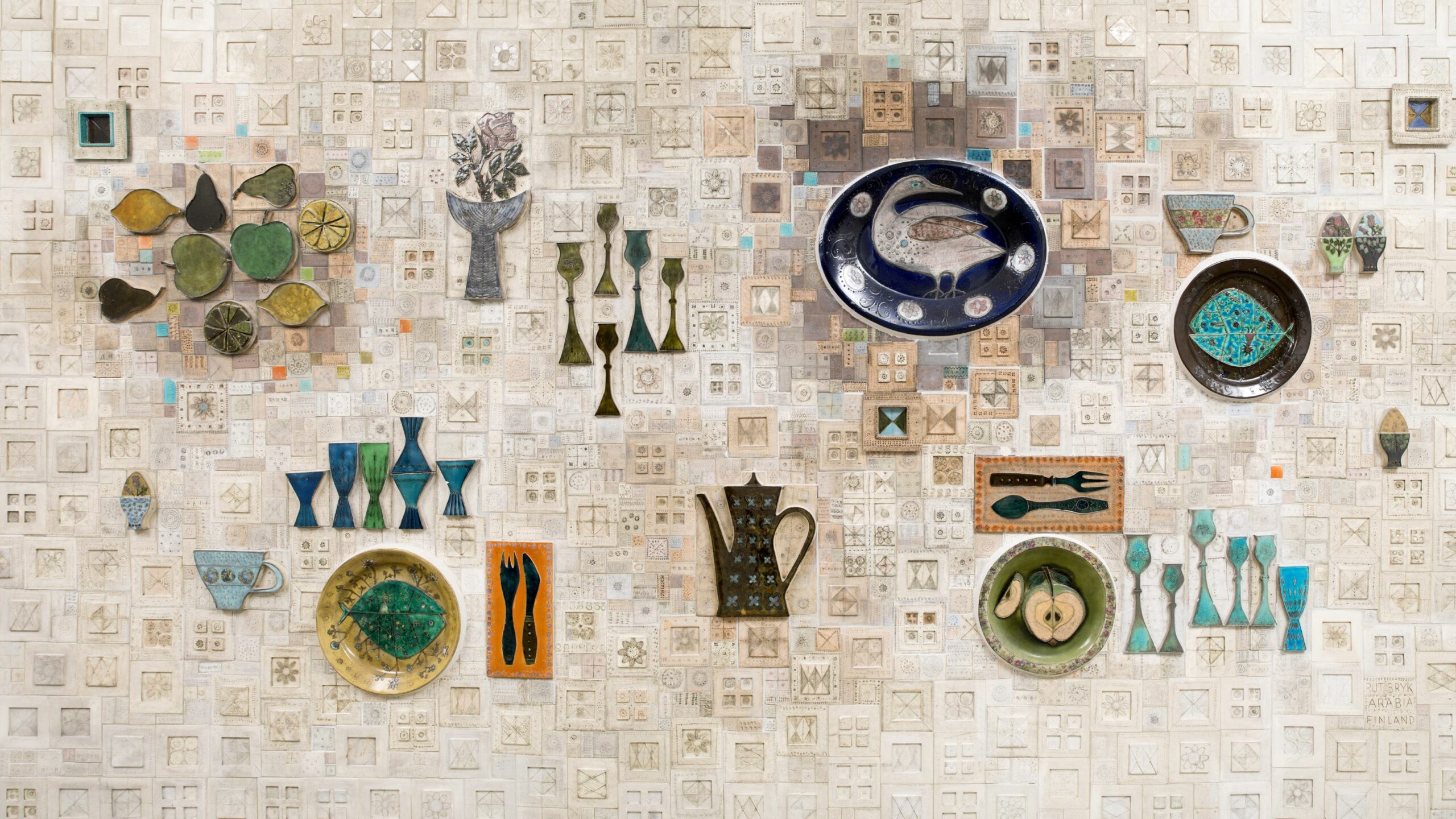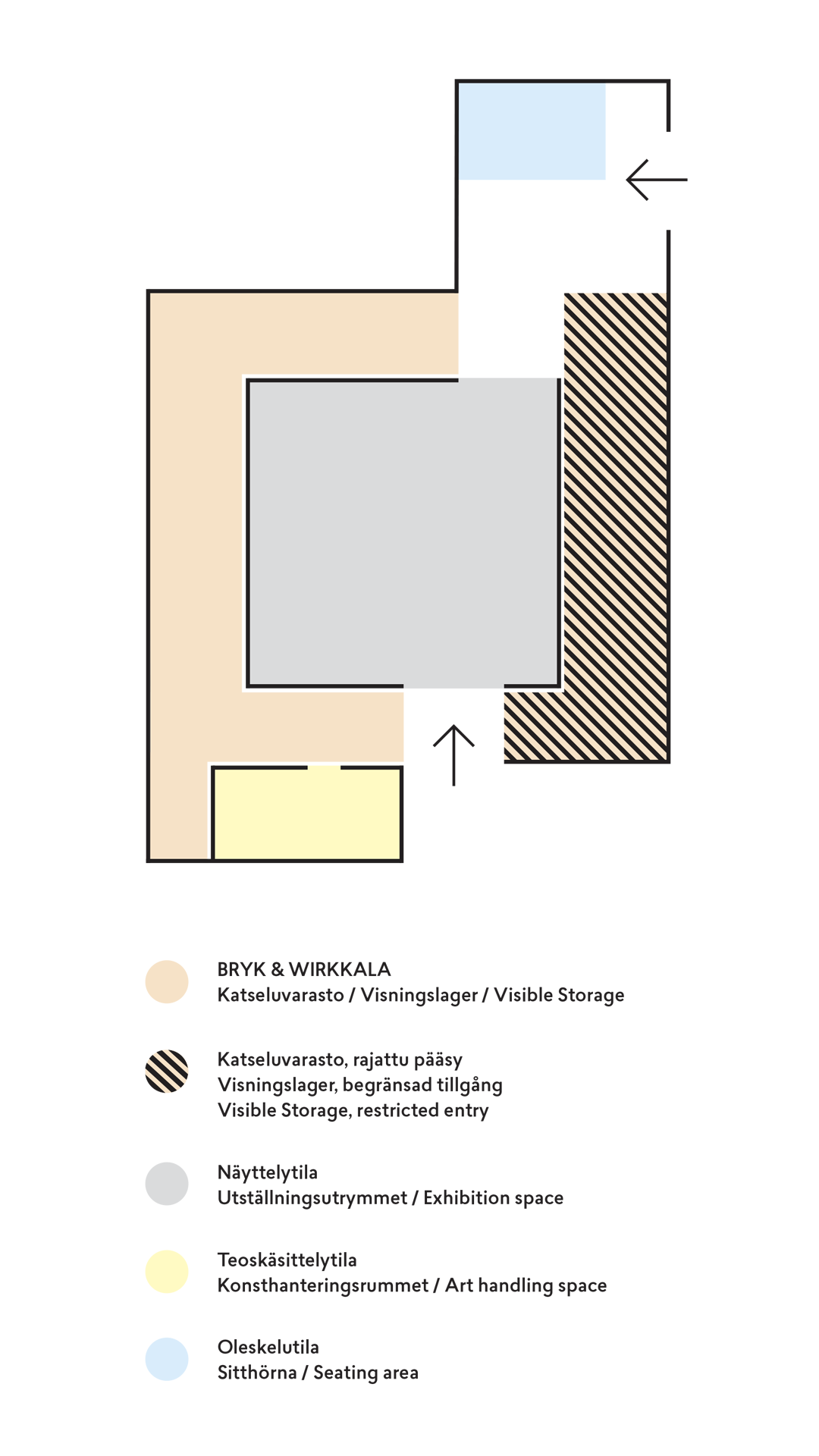Espoo Museum of Modern Art
Mobile Guide to Bryk & Wirkkala Visible Storage

The content of the mobile guide showcases Rut Bryk (1916–1999) and Tapio Wirkkala’s (1915–1985) key sources of inspiration: Nordic nature and the international design scene. Drawing on archive material, it looks at the birth process and techniques used by Bryk, while taking a parallel look at Wirkkala’s creative process, his philosophy of form, and his role in the international breakthrough of Finnish design.
From the late 1960s, artist couple spent their summers in Lapland. The Lemmensuu estate by Lake Paadar became their fixed summer residence. The family set off for Lapland in the beginning of summer and returned to the city as autumn arrived. The northern wilderness, its constantly shifting details and the seasonal changes, which affected the scenery, light and people, greatly influenced the work of both artists.
Just as important as the nature of Lapland was the connection with the world, the cultural heritage of Europe and current phenomena. In 1965, Tapio Wirkkala began working as a designer at Venini glass factory, which made Venice another important location for the family. The artist couple shared a love for Italian culture, especially early-Renaissance art.
Rut Bryk

Before Ceramics

Rut Bryk originally studied to be a graphic artist. Before the founder of Arabia’s art department Kurt Ekholm discovered the promising artist in the making, Bryk carved linoleum instead of clay tiles and plaster casts. In the linocut technique, parts of the linoleum plate used as floor material are removed, leaving empty spots for printing. The ready image is created with one or several plates and colours.
In the 1930s and 1940s, Bryk left her mark on magazine illustrations. Recurring subjects included human figures, interiors and plants. The graphic expression was still visible during Bryk’s shift into ceramics through graphic and serial qualities.
Toward A Work of Art

The Arabia factory gave Rut Bryk the means for creating her life’s work. She worked at the factory’s Art Department from 1942 up until the completion of Ice Flow, the wall relief at the official residence of the president of the Republic of Finland, in 1991. Bryk had a special status in the unique environment of the Arabia Art Department to express her own ideas.
Although Bryk worked wherever she was, Arabia remained for her a constant, a place where her works acquired their final form in the hands of artisans and from whence they went out into the world. The Arabia laboratory developed the clay mixtures and the more than a hundred glazes that Bryk used in her work. As the tiles she used became smaller, the artworks became increasingly laborious to produce. Her assistant, Kirsti Bruun-Micklin, was in charge of the technical production of Bryk’s works from 1967 onwards. Other irreplaceable assistants were tile caster Erkki Järvinen and carpenter Nikolai Makaroff.
From Mould to a Finished Work
Rut Bryk carved her motifs on clay or plaster tiles. The most simple mould was made by casting a separate frame made of plaster around the plaster tile. Moulds made of two or even three parts made it possible to create three-dimensional works that were thicker than the original tile. The work would then be carved hollow in the casting phase before being fired.
The casting clay was poured into a mould and then detached while still moist. At times Bryk would continue to make patterns by cutting the edges or drawing straight onto the clay. After the initial firing, the tile could be worked on more by using coloured glazes or by painting it in the mould phase with engobe clay slurries. The same mould would sometimes be used again and because of this, some old moulds have repair marks. Rut Bryk signed her works on the tile or directly in the mould in mirror writing.
Artworks
Corpus Domini, 1953

Corpus Domini was inspired by a Sicilian celebratory procession that Rut Bryk experienced in Taormina in 1949 together with her husband Tapio Wirkkala. The full work (86 x 139 cm) is comprised of seven ceramic tiles of different sizes. Bryk realised many ceramic works with the same theme as Corpus Domini, with their edges cut into shapes of buildings. Besides Italy, the imaginary buildings also draw inspiration from Bryk’s childhood in Finnish Karelia. Different versions of the parts of Corpus Domini as well as moulds are on display at the Bryk & Wirkkala Visible Storage.
Banquet Table, 1958–1961

Banquet Table (ca. 300 x 500 cm) is one of Ryt Bryk’s first large-scale artworks. It is located in Selb, Germany at the Rosenthal porcelain factory. Banquet Table is also one of the last works where Bryk still used clearly figurative motifs: fruits, dishes and ashtrays. The work is composed of tiles, a basic element that Bryk also used for her later work. Bryk revisited the motifs of the table on a smaller scale in many other works. The selection includes independent works and sketches that explore the same topics.
Documentary

Rut Bryk: Perhosen kosketus (“Touch of a Butterfly”) is a warm portrayal of Rut Bryk. In the intimate documentary film, experts on the artist and her immediate circle convey an image of Bryk as a person at home in both global metropolises as well as the middle of Lapland’s wilderness.
Watch the documentary on EMMA Zone! → www.emmazone.fi ←
EMMA Zone is the digital home of EMMA. The site offers a variety content about art, design and the museum’s work under four categories: Thinking Zone, Behind the Scenes at EMMA, Bubbling Underand Children’s Art Questions.
EMMA Zone – always open for art!
Tapio Wirkkala

It All Starts With The Hands

Tapio Wirkkala’s oeuvre extends from serially produced everyday items to unique sculptures. Wirkkala worked as a freelance designer for both Finnish and international companies and as the head of his own Design Tapio Wirkkala design company. He had a bold approach, simultaneously designing packaging for food products as well as plywood artworks.
Wirkkala’s number one tool was his hands, which he used for drawing and sculpting. His creative mind and able hands resulted in designs, which were realised together with some of the best glass-blowers and carpenters. Yet his most stunning glass molds were carved by the artist himself, using chisels and a sheath knife of his own design.
From A Shape to An Item

Tapio Wirkkala was drawn to geometry-based classical compositions. Basic shapes, such as a circle and cube, are behind each design, regardless of the final product. Wirkkala’s materials included wood, glass, plastic and metals. By varying basic shapes Wirkkala created entire glass series, such as Kartio (1956) and Romantica (1962).
Every item was based on a long design process. In both art and design, the work would always begin with sketches, sometimes even dozens of them, in order to find the final shape. Dimensional drawings then followed, and the objects were tested with the help of prototypes. The design process could be seen in the end product’s usability, appearance and feel: the item is exactly the way it is supposed to be.
A Designer of International Finland

Tapio Wirkkala was successful as an artist, designer and exhibition architect. His national and international breakthrough took place in 1951 at the Milan Triennial IX, where Finland’s display and Wirkkala as its exhibition architect were praised by the media.
Wirkkala was later hired as an architect for several projects highlighting Finland and its art industry. In addition to triennials and world fairs, travelling exhibitions designed by Wirkkala were showcased across Western and Eastern Europe and the United States. As a curator, Wirkkala displayed his colleagues’ work extensively while also including works of his own in the exhibitions. International travelling exhibitions helped to strategically portray Finland as an independent and modern country.
City of The Future

Tapio Wirkkala won an international competition, where he competed by invitation, arranged in conjunction with the 1958 Brussels World Fair. The theme of the competition was City of the Future 2000. The display includes sketches of an innovative and playful utopia, archival photographs of a lost miniature and a visualisation of the city by Voima Graphics from 2018.
City of the Future consists of large, sculptural residential blocks where residents are transported with an electric monorail. Wirkkala also envisioned details inside homes, such as the precursor of a microwave, screenphone and digitally alternating window scenery, along with decor paintings. Wirkkala was enthusiastic about futuristic utopias and learnt about plastic materials when working with designer Raymond Loewy’s agency in New York during 1955–1956.
Bryk & Wirkkala Visible Storage

- The Visible Storage showcases some 2,500 objects from the extensive output of artist couple Rut Bryk (1916–1999) and Tapio Wirkkala (1915–1985).
- Tapio Wirkkala Rut Bryk Foundation Collection deposited at EMMA includes works of art, objects, models, sketches, photographs and archival materials.
- Items in the Visible Storage are displayed in two ways. Most of them are arranged in compact groups on the storage shelves, while some are hung on the walls and accompanied by texts that provide background information.
- An exhibition space in the centre presents design and art objects in relation to the collection.
- Conservators and photographers occasionally work in the space behind the glass wall. The other half of the storage is reserved exclusively for museum work. In the seating area near the windows you can study materials and literature related to Bryk and Wirkkala.
Map
